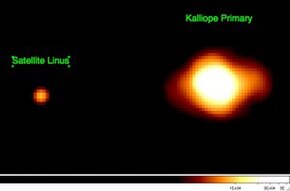22 Kalliope
 Kalliope and satelliteLinusas seen by theW.M. Keck II telescopein 2010 | |
| Discovery | |
|---|---|
| Discovered by | John Russell Hind |
| Discovery date | 16 November 1852 |
| Designations | |
| (22) Kalliope | |
| Pronunciation | /kəˈlaɪ.əpi/kə-LY-ə-pee[1] |
Named after | ΚαλλιόπηKalliopē |
| Main belt | |
| Adjectives | Kalliopean/kəˌlaɪ.əˈpiːən/kə-LY-ə-PEE-ən |
| Orbital characteristics[2] | |
| Epoch23 July 2010 (JD2455400.5) | |
| Aphelion | 479.98Gm(3.2085AU) |
| Perihelion | 391.03 Gm (2.6139 AU) |
| 435.09 Gm (2.9112 AU) | |
| Eccentricity | 0.10213 |
| 1814.3 d (4.97yr) | |
| 282.54° | |
| Inclination | 13.703° |
| 66.17° | |
| 355.03° | |
| Knownsatellites | Linus |
| Physical characteristics | |
| Dimensions | 235 km × 144 km × 124 km[3] 190 km × 125 km[4] |
| Flattening | 0.41[a] |
| Mass | (7.7±0.4)×1018kg[5] (8.16±0.26)×1018kg[3] 7.36×1018kg[6] (6.30±0.50)×1018kg[7] |
Meandensity | |
| 0.17285 days (4.1483 h)[2] | |
| 0.198[5] 0.17[3] 0.166 ± 0.005[2] | |
| 6.81[2] | |
22 Kalliope(/kəˈlaɪ.əpi/;kə-LY-ə-pee) is a largeM-type asteroidfrom theasteroid beltdiscovered byJ. R. Hindon 16 November 1852. It is named afterCalliope,theGreekMuseofepic poetry.It is orbited by a small moon namedLinus.
Characteristics
[edit]
Kalliope is somewhat elongated, approximately 166 km indiameter,[3]and slightly asymmetric, as evidenced by resolved images taken with theVLTat theEuropean Southern Observatory.This new diameter, which was measured by observing mutual eclipses of Kalliope and Linus, is 8% smaller than that calculated fromIRASobservations.[3]
The spectrum of Kalliope is anM-type,indicating that its surface may be partially composed ofiron–nickelmetal. The asteroid's density is about 3.4 g/cm3.[3]Since the asteroid is likely to be arubble pile,accounting for a possible porosity of 20–40% leads to the material density of 4.2–5.8 g/cm3,which means that Kalliope is probably made of a mixture of metal withsilicates.[3]Spectroscopic studies have shown, however, evidence ofhydratedminerals[9]and silicates,[10]which indicate rather a stony surface composition. Kalliope also has a low radar albedo,[6]which is inconsistent with a purely metallic surface.
Lightcurve analysis indicates that Kalliope's pole most likely points towardsecliptic coordinates(β, λ) = (−23°, 20°) with a 10° uncertainty,[11][7]which gives Kalliope anaxial tiltof 103°. Kalliope's rotation is then slightly retrograde.
Between 2004 and 2021, 22 Kalliope has been observed tooccultfifteen stars.
Satellite
[edit]Kalliope has one known natural satellite, called Linus or (22) Kalliope I Linus. It is quite large – about 28 km in diameter – and would be a sizeable asteroid by itself. It orbits about 1100 km from the center of Kalliope, equivalent to about 13.2 Kalliope radii.[3]Linus was discovered on 29 August 2001 byJean-Luc MargotandMichael E. Brown,while another team led by William Merline also independently detected the moon 3 days later.[6][7]
First stellar occultation
[edit]On 7 November 2006, the first stellar occultation by the satellite of an asteroid (Linus) was successfully observed by a group of Japanese observers[4]according to a prediction that was made just one day before by Berthier et al.[12]based on more than 5 years of regular observations of Kalliope binary system usingadaptive opticssystems on ground-based telescopes. The observedchordsof Linus give a unique opportunity to estimate the size of the moonlet which was estimated to 20–28 km.
Notes
[edit]References
[edit]- ^"calliope".Oxford English Dictionary(Online ed.).Oxford University Press.(Subscription orparticipating institution membershiprequired.)
- ^abcdefg"JPL Small-Body Database Browser: 22 Kalliope"(2010-06-02 last obs).Retrieved22 July2010.
- ^abcdefghijDescamps, P.; Marchis, F.; et al. (2008). "New determination of the size and bulk density of the binary asteroid 22 Kalliope from observations of mutual eclipses".Icarus.196(2): 578–600.arXiv:0710.1471.Bibcode:2008Icar..196..578D.doi:10.1016/j.icarus.2008.03.014.S2CID118437111.
- ^abM. Sôma, et al. (2006). "'Occultation by Kalliope (22) and its satellite Linus ".Central Bureau Electronic Telegrams.732:1.Bibcode:2006CBET..732....1S.
- ^abcdeVernazza, P.; et al. (October 2021)."VLT/SPHERE imaging survey of the largest main-belt asteroids: Final results and synthesis".Astronomy & Astrophysics.654:A56.Bibcode:2021A&A...654A..56V.doi:10.1051/0004-6361/202141781.hdl:10261/263281.S2CID239104699.
- ^abcdeJ.L. Margot & M.E. Brown (2003). "A Low-Density M-type Asteroid in the Main Belt".Science.300(5627): 1939–1942.Bibcode:2003Sci...300.1939M.doi:10.1126/science.1085844.PMID12817147.S2CID5479442.
- ^abcdeF. Marchis (2003). "A three-dimensional solution for the orbit of the asteroidal satellite of 22 Kalliope".Icarus.165(1): 112–120.Bibcode:2003Icar..165..112M.doi:10.1016/S0019-1035(03)00195-7.
- ^"EAR-A-5-DDR-TAXONOMY-V6.0".Planetary Data System.Archived fromthe originalon 17 December 2015.Retrieved16 April2018.
- ^A.S. Rivkin (2000). "The nature of M-class asteroids from 3-micron observations".Icarus.145(2): 351–368.Bibcode:2000Icar..145..351R.doi:10.1006/icar.2000.6354.
- ^D.F. Lupishko (1982). "UBV photometry of the M-type asteroids 16 Psyche and 22 Kalliope".Solar System Research.16:75.Bibcode:1982AVest..16..101L.
- ^M. Kaasalainen (2002)."Models of Twenty Asteroids from Photometric Data"(PDF).Icarus.159(2): 369–395.Bibcode:2002Icar..159..369K.doi:10.1006/icar.2002.6907.
- ^J. Berthier, et al. (2004). "'Prediction of stellar occultations by satellite of asteroids ".AAS/Division for Planetary Sciences Meeting Abstracts #36.32(23): 1142.Bibcode:2004DPS....36.3223B.
External links
[edit]- Lightcurve plot of 22 Kalliope,Palmer Divide Observatory,B. D. Warner(2007)
- orbit diagram for Linus
- A different VLT image of Kalliope and Linus
- (22) Kalliope,datasheet, johnstonsarchive.net
- Asteroids with Satellites,Robert Johnston, johnstonsarchive.net
- [1],Prediction and Reduction of Stellar Occultations of Binary Asteroids
- 22 KalliopeatAstDyS-2, Asteroids—Dynamic Site
- 22 Kalliopeat theJPL Small-Body Database

